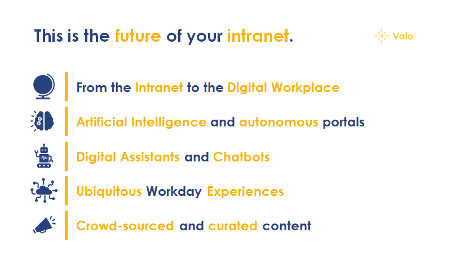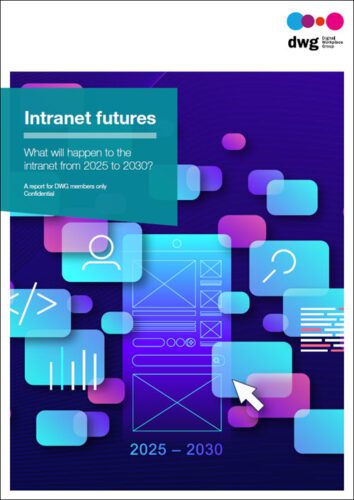Intranets now and in the future – insights from Valo at the DWG Institute Technology Lab
This June, the DWG Technology and Research Institute held a successful Technology Lab, hosted online from Chicago and bringing together practitioners and providers to share insights into accelerating the digital workplace. We were thrilled that Valo, a leading intranet “in a box” provider, was one of the companies involved on the day. We got some great insights and excellent presentations from the team:
- Vlad Catrinescu, Product Evangelist, Valo
- Sebastien Levert, Product Lead, Valo
During the Lab, the team from Valo led two sessions. The “Illuminate” section covered rapidly deploying an intranet that still has some customization, while the “Innovate” session focused on future intranet trends.
Can you quickly deploy a custom intranet?
In the “Illuminate” section, Valo’s Vlad Catrinescu gave a short presentation around “Rapid deployment of a custom look and feel intranet”, based on experiences of working with Valo’s “in a box” intranet software. The title is intriguing because there is often a perception that there must be a trade-off between a custom intranet suited exactly to the needs of your organization and the ability to successfully deploy it quickly, whereas standardized approaches and intranet products allow for that more rapid roll-out. Is it possible to combine the advantages of a rapid roll-out and a custom intranet?

In suggesting a solution, Vlad explored the history of intranets, showing how successive tools, such as enterprise social networks and chat-based tools, had merely complemented the intranet rather than replaced it, and how the intranet as a trusted information source had proved critical during the COVID-19 crisis.
Vlad also talked about the length of time associated with intranet projects. Using data compiled by the Nielsen Norman Group, the average length of an intranet project has been shown to be around 1.2 years. Although this data set is small, it does illustrate that many intranet projects are still associated with a major investment in time, yet some roll-outs associated with using “in a box” products are much quicker. It’s perfectly possible to launch a great intranet in months, or weeks even.
Vlad suggested that there is a successful way to launch an intranet quickly and yet still have a custom look and feel plus the digital workplace integrations that are going to suit the intranet to the unique needs of your organization.

The 80% and the 20%
At the root of Vlad’s argument was that, while every intranet is unique, 80% of the functionality is actually the same, for example delivering news on the homepage, global navigation, the ability to comment and share items, and so on. Vlad argued that this means there is little point in building a custom intranet from scratch, a process which is very time-consuming (and can be costly); instead, it is better to use a prebuilt solution that covers the “80%”, allowing for a rapid deployment, which can be important, particularly in uncertain and volatile times.
So what about the remaining 20% of the intranet that you need to be unique to you? Vlad argued that 10% of this can usually be configured within the confines of your intranet product, leaving the remaining 10% to be driven from customization, principally through integrating different digital workplace tools.
Even this remaining 20% does not have to delay your intranet project because, as most of us know, an intranet and digital workplace is never finished. You don’t need all your features in Phase 1 and you can add custom integrations as you go; indeed, there can be some advantages to this approach, as you learn how your users use the intranet and pick up ideas from your intranet champions.
What does the future hold for intranets?
In the “Innovate” section, Valo’s Sebastien Levert cast his eye to the next few years in a session titled “What does the future hold for intranets?”. Sebastien explored five directions of travel for the intranet, many of which resonated with the participants in the discussion. These five trends are explored below.

1. From the intranet to the digital workplace
The move to the digital workplace is something virtually every intranet team will recognize. Intranets have already been on a journey and come a long way, adding extra capabilities beyond their traditional role as an internal communications platform. Sebastien suggested that “collaboration” and “co-innovation” are two additional pillars that need to be part of any intranet journey.
Sebastien also emphasized that integrations from different tools and apps are what make a “digital workplace” truly sticky; the job of an intranet should now be to help employees be more productive and to provide a “delightful” experience of the tools that will drive this increase in productivity.
2. Artificial intelligence and autonomous portals
Artificial intelligence (AI) is still one of those terms that can provoke both good and bad reactions, but Sebastian suggested it will increasingly become part of the intranet experience.
Sebastian particularly sees this happening through AI-driven categorization and tagging of content, which will bring value and context to it, pointing out that Microsoft’s Project Cortex is actively developing this now. Interestingly, this was a theme in which a couple of the organizations participating in the Lab stated they were particularly interested.
All this means that ultimately AI will also impact the intranet experience, for example driving the content highlighted on a themed landing page and delivering highly personalized experiences in ever-changing portals.

3. Digital assistants and chatbots
Another trend that many of us in the Lab recognized is the increasing deployment of digital assistants and chatbots. Sebastien posed the question of whether we’re ready for a “chatbot revolution” that can ultimately deliver value in different ways including:
- being able to get the right answer to a question at any time
- delivering content in context, just when you need it most
- detecting workplace trends and driving innovations based on user behaviours.
4. Ubiquitous workday experiences
Another trend that some of us will recognize is happening right now is the way in which the intranet is becoming part of a “ubiquitous” digital workplace experience that is familiar, whatever channel you are in. As Sebastien put it, this experience is available “in your browser, in Microsoft Teams, in your pocket, in your emails, everywhere”.
This trend certainly appears to be true with the current evolution of Microsoft Teams, which is increasingly becoming an interface into other parts of the digital workplace, as well as with the evolution of better mobile apps.
5. Crowd-sourced and curated content
A good intranet relies on good content. With intranets now increasingly working on higher levels of participation and content contribution, how do we harness this power and effectively crowdsource and curate content to add value across the organization? He posed the question: “Who is the owner of all that content?”, a potentially interesting conundrum going forward, particularly as we harness the power of AI to surface much of it.
Our thanks to Vlad and Sebastien for two great sessions!
Slides from the Tech Lab
Take the next steps…
Categorised in: → DWG Institute, Intranets

